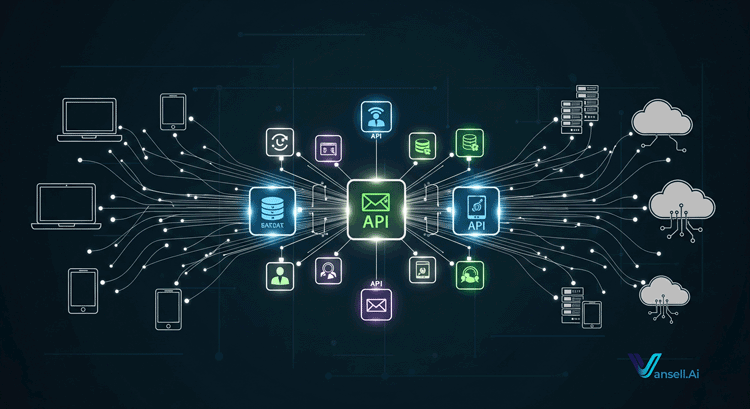APIs and How They Connect the Web
Understanding the Backbone of Modern Web Communication

The Invisible Connectors of the Web
When you open a weather app on your phone, book a ride on Uber, or check the latest posts on Instagram, you’re using APIs without even realizing it. APIs are like friendly messengers that carry requests from one software to another and bring back the needed data. Without them, our digital lives would be a lot less connected, and our favorite apps would lose many of their powers.
In today’s digital ecosystem, APIs aren’t just helpful—they’re essential. They enable cross-platform integration, speed up development, and allow developers to build on top of existing services instead of reinventing the wheel.
2. What Is an API?
An API, or Application Programming Interface, is a set of rules that defines how two software applications can communicate. Think of it as a waiter in a restaurant. You (the user) tell the waiter what you want, the waiter delivers your order to the kitchen (the system), and then brings your food back. You don’t need to know how the chef prepares your meal—you just need to trust the waiter to deliver it.
From a technical perspective, an API defines:
Endpoints: The specific URLs or addresses where requests are sent.
Methods: Such as GET, POST, PUT, DELETE—each indicating a different type of action.
Data format: Typically JSON or XML for web APIs.
Rules and authentication: To ensure secure and correct usage.
3. Why APIs Matter
APIs are the glue of modern web and mobile applications. They enable:
Integration: Connecting different systems (e.g., PayPal API for payments).
Scalability: Allowing services to grow and connect with others.
Speed: Developers can use existing APIs instead of building entire systems from scratch.
Innovation: APIs open up opportunities for developers to create new tools, services, or apps by combining multiple API functionalities.
4. Real-World Examples of APIs in Action
Here are a few common scenarios:
Google Maps API: Lets developers embed maps into websites and apps.
Stripe API: Handles secure online payments.
Twitter API: Allows apps to fetch tweets or post updates.
OpenWeather API: Provides weather data for any location worldwide.
Spotify API: Gives access to music data, playlists, and playback controls.
Every time you use a third-party login like “Sign in with Google” or “Login with Facebook,” you’re using an authentication API.
5. Types of APIs
Not all APIs are the same. They can be categorized based on accessibility, purpose, and architecture.
5.1 By Accessibility:
Open APIs (Public APIs): Available to anyone, often with usage limits.
Partner APIs: Shared with specific business partners.
Internal APIs (Private APIs): Used only within a company.
5.2 By Purpose:
Web APIs: For internet-based communication.
Operating System APIs: Like Windows API or macOS API for software interacting with the OS.
Database APIs: To query and manipulate databases.
Hardware APIs: To interact with devices like cameras, printers, or sensors.
5.3 By Architecture:
REST APIs: Use standard HTTP methods and are lightweight, scalable, and easy to understand.
SOAP APIs: More rigid, using XML for messaging—often found in enterprise systems.
GraphQL APIs: Allow clients to request only the data they need.
gRPC: High-performance, often used in microservices.
6. How APIs Work in Frontend and Backend Development
APIs play roles in both sides of development.
Frontend Use:
Fetching dynamic content (e.g., news articles from a headless CMS).
Sending form submissions to a backend server.
Integrating third-party widgets like chatbots or maps.
Backend Use:
Processing data from the frontend.
Communicating with external services (payment gateways, shipping providers).
Handling complex business logic while keeping the frontend lightweight.
Example: A weather website’s frontend calls an API to get temperature data. The backend API request is sent to a weather service API, which returns JSON data. The frontend then displays it to the user.
7. Authentication and Security in APIs
Since APIs often handle sensitive data, authentication is critical.
Common methods:
API Keys: Simple but less secure.
OAuth: Widely used for third-party logins and permissions.
JWT (JSON Web Tokens): Securely transmit information between parties.
HMAC (Hash-based Message Authentication Code): Ensures message integrity.
Developers must also guard against:
Rate limiting abuse (too many requests in a short time).
Data leaks.
Injection attacks.
8. API Documentation: The Developer’s Guide
Good API documentation is like a detailed manual—it tells developers exactly how to use it. It should include:
Endpoint descriptions
Request and response examples
Error codes
Authentication methods
Tools like Swagger (OpenAPI) and Postman help in creating and testing APIs.
9. Future Trends in APIs
APIs are evolving alongside technology. Key trends include:
AI-powered APIs: Like ChatGPT’s API for natural language processing.
Event-driven APIs: Responding to real-time triggers.
Serverless APIs: Running without dedicated servers.
API Monetization: Companies selling API access as a product.
With IoT (Internet of Things) expanding, APIs will become even more important for connecting devices to each other and the internet.
10. Conclusion: APIs as the Backbone of Digital Communication
APIs make modern life easier by enabling seamless interaction between different apps, platforms, and devices. They reduce development time, open doors for innovation, and make it possible for businesses to grow faster. Whether you’re a developer building a new app or a business looking to expand your service reach, understanding APIs is no longer optional—it’s essential.https://vansell.ai/web-development

